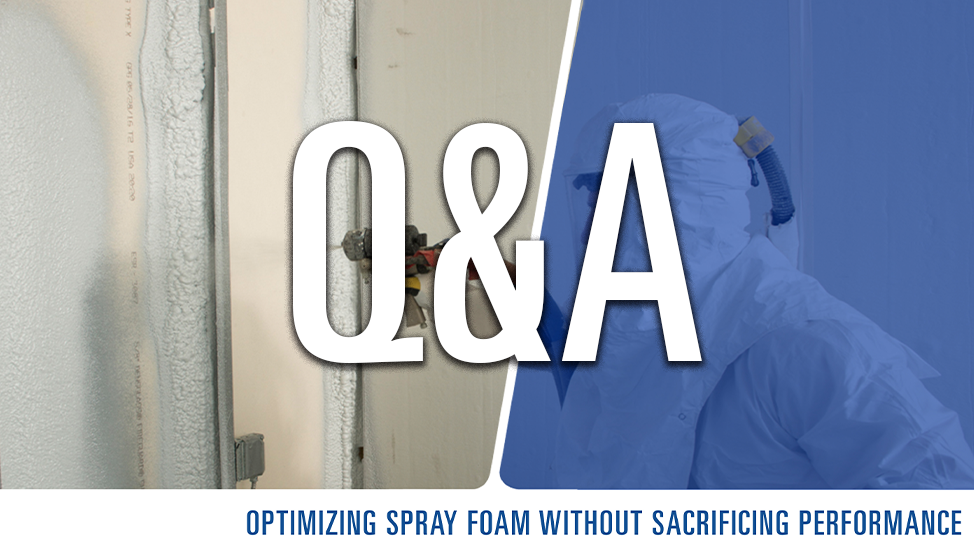In late September, we hosted a webinar discussing the latest research on the efficacy and long-term resiliency of high lift spray foams. The webinar led to a variety of excellent questions, and we picked five great questions for our hosts to answer below. If you have additional questions about spray foam, please contact the JM TechConnect team for assistance.
1. Is the moisture barrier needed when using a closed-cell spray foam?
a. An additional vapor retarder is not necessary where closed-cell spray foam, such as JM Corbond® III, is installed at 1.5 inches or above. Since JM Corbond III qualifies as a Class II vapor retarder, it serves as a moisture barrier when properly installed. Open-cell spray foam, on the other hand, permits the transmission of water vapor and requires a moisture barrier.
2. Can total thickness over 7 inches be installed, in multiple passes?
a. Yes, JM Corbond III can be sprayed in multiple passes to thicknesses greater than 7 inches; however, at thicknesses above 7 inches, a waiting period will be required to allow the foam to cool sufficiently between passes. The exotherm evaluation for immediate passes up to 7 inches is outlined in our recent white paper, Exploring the Efficacy of High Lift Spray Foam Insulation. If you would like more information about installing JM Corbond III, you can refer to our resources online or reach out to the JM TechConnect Team.
3. How do you determine the speed of a pass for different thicknesses?
a. Determining an exact rate of motion to achieve a certain thickness is best learned through practice and experience. There isn’t a specific rate or speed that could be identified for every installer, with every rig, and for every brand of spray foam. This will vary from person to person and can even vary from job to job depending on the temperature. In general, thinner passes take less time to install than thicker passes because the longer a specific area is sprayed, the thicker the pass will be. JM offers a Spray Foam Certification Course that covers installation techniques, along with many other best practices to help optimize your spray foam installation.
4. Are high lift foams better for thermal resistance due to the lack of "skin" between multiple passes?
a. “Skin” between passes may have a slight impact on overall thermal resistance. Since the skin doesn’t contain bubbles of highly insulating blowing agent, it has less insulating power than the underlying foam. That being said, the skin comprises only a slight fraction of the overall foam insulation. When we consider high lift foams, we know that they won’t have any skin between layers because there is only one layer; however, high lift foams may also exhibit blowing agent loss through poor closed-cell content. As explained in Exploring the Efficacy of High Lift Spray Foam Insulation, poor closed-cell content negatively impacts thermal resistance and leads to poor dimensional stability potentially causing the material to detach the substrate. When determining the optimal installation method for a closed-cell spray foam, all of these factors must be considered to ensure the insulation system performs as designed.
5. What about using a couple of inches of closed-cell, then topping off the cavity with open-cell?
a. Hybrid systems involving the use of closed-cell spray foam plus another insulation (open-cell spray foam or fibrous insulation like mineral wool or fiberglass) are great solutions for balancing performance and budget. JM recommends that any hybrid system utilizing closed-cell spray foam should include at least 1.5 inches of JM Corbond III as the first layer of the system. This checks two critical aspects of a wall system off the list: the air barrier and the vapor retarder. Additionally, closed-cell spray foam is a sound substrate for open-cell spray foam to be applied to, and its smooth surface provides a good base layer for fiberglass, mineral wool, blowing wool, and more.
Keep in mind that if you are using the same equipment to spray closed-cell foam and open-cell foam, you will need to ensure your entire system is clear of one foam before switching to the next.
Click here to watch the full version of the recorded webinar. If you would like to download the accompanying white paper, please click here.

